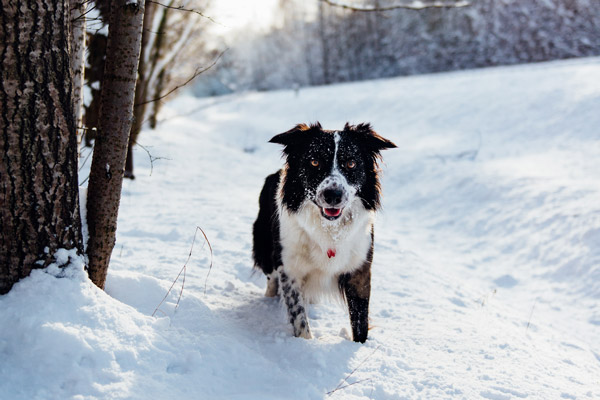When exercising your dog outdoors in the cold, you will need to take the necessary precautions to ensure that your dog is safe and warm. Purchase a waterproof vest to keep your dog warm. You might also want to invest in a pair of booties to keep your dog’s paws warm and safe. Motivate your dog to exercise outside by introducing new games, toys, and paths to explore. If it is too cold to exercise outside, there are a variety of indoor activities you can do that will fulfill your dog’s exercise needs.
Keeping Your Dog Warm and Safe
Purchase a vest or coat. If your dog has a short coat, is a puppy or a small breed, or is older you will need to purchase a vest or coat for your dog. The vest will provide your dog with the additional warmth it needs to exercise and play outside. A vest is necessary especially if you and your dog are going on a long walk or hike.[1]
- Purchase a waterproof vest from your local pet supply store.
- Always make sure the vest is dry before putting it on your dog.
Massage petroleum jelly onto its paws. Ice, salt, snow, and the cold ground can all crack, sting, and dry out your dog’s paws. This can cause discomfort, pain, and bleeding. In order to prevent this, apply petroleum jelly or another protectorate onto your dog’s paws before going outside.[2]
- Alternatively, you can purchase dog booties from your local pet supply store. Booties will keep your dog’s paws warm and protected. Before going outside, acclimate your dog to the booties. Place them on your dog’s paws. Praise and reward your dog with treats for good behavior.
Wipe its paws afterwards. Icy and snowy streets and sidewalks may contain chemical de-icers. De-icers can be harmful to your dog if ingested. Therefore, after a day of exercise and fun in the snow and ice, make sure to clean your dog’s paws and belly. Use a clean towel with warm water to wipe its paws and belly down.[3]
- Also, use a dry towel to wipe down your dog to ensure that its fur is dry.
- Bring a towel with you on your walks so you can wipe away ice and snow as needed.
Up your dog’s caloric intake. Your dog’s body uses more energy to keep itself warm outdoors in the cold. Therefore, you may need to feed your dog extra food so its body can create enough energy to keep it warm.[4]
- During the winter months, feed your dog 15 percent more for every 20-degree drop in temperature.[5]
Monitor your dog. When outside, make sure to monitor your dog for signs of being too cold. Signs that your dog is too cold are shaking/shivering, whining or barking, hunched posture with a tucked tail, and lifting its paws off the ground. Other signs include changes in behavior (seeming anxious or uncomfortable), a reluctance to keep walking, or wanting to go inside.[6]
- Take your dog inside if it is displaying these signs.
- In general, if the weather is too cold for you, then it is most likely too cold for your dog as well. Avoid going outside on these days.
Motivating Your Dog
Change your routine. A slight change in routine may just be the motivation your dog needs to go outside on cold days. Walk a different path in your neighborhood, or take your dog to the dog park or another hiking trail instead of the usual one.
- New toys or games may also entice your dog to go outside. Purchase a new toy or introduce a new game to your dog.
Try skijoring. Skijoring is like dog sledding, but instead of pulling you on a sled, your dog pulls you while you are on skis. Your dog must be at least 30 pounds in order to do this activity. You will need to purchase an appropriate sized pulling harness for your dog. Your dog should also know basic commands before engaging in skijoring.[8]
- You will also need to purchase a 6 to 10 foot gangline and a skijoring belt—a rock climbing harness or a weight lifting belt will work as well.
- Attach the gangline to your belt and to your dog’s harness and enjoy skijoring.
Exercising Your Dog Indoor
Play fetch. Play fetch in a long hallway or open space in your house with one of your dog’s favorite toys. To make it more challenging, throw the object up a stairway. Tug-of-war is also a good game to play inside if your house is too small for a game of fetch.[9]
- Alternatively, walk your dog up and down the stairs while on a leash. Run up and down, take two steps at a time, or climb the stairs sideways for an additional challenge.
Make a scavenger hunt. For dinnertime, place your dog’s food in different places throughout your house. Help your dog by making a trail of dog food leading from one spot to the next. This exercise will challenge your dog’s nose and stimulate its mind at the same time.[10]
- You can also place your dog’s food in a food puzzle, like a Kong, to keep it busy for a couple hours.
Sign your dog up for an exercise class. Indoor exercise classes, like indoor swimming or yoga, are a great way to fulfill your dog’s exercise needs when you need a change of scenery. Sign your dog up for a class at your local pet supply store, or search for classes online.[11]
- Exercise classes also have the added benefit of socializing your dog and increasing its mental agility.
Sources:
- ↑ https://www.petfinder.com/dogs/dog-care/how-to-exercise-your-dog-in-cold-weather-2/
- ↑ https://www.petfinder.com/dogs/dog-care/how-to-exercise-your-dog-in-cold-weather-2/
- ↑ https://www.petcarerx.com/article/7-ways-to-exercise-your-dog-in-cold-weather/669
- ↑ http://www.aspca.org/pet-care/general-pet-care/cold-weather-safety-tips
- ↑ https://www.utahhumane.org/our-programs/investigation/cold-weather-care-dogs
- ↑ http://ontariospca.ca/blog/cool-test-how-to-tell-if-your-dog-is-too-cold/
- ↑ https://www.petcarerx.com/article/7-ways-to-exercise-your-dog-in-cold-weather/669
- ↑ http://www.petguide.com/petcare/dog/need-to-know-tips-getting-started-in-skijoring/
- ↑ http://www.vetstreet.com/our-pet-experts/5-ways-to-keep-your-dog-active-indoors
- ↑ http://www.vetstreet.com/our-pet-experts/5-ways-to-keep-your-dog-active-indoors
- ↑ https://www.petfinder.com/dogs/dog-care/how-to-exercise-your-dog-in-cold-weather-2/

